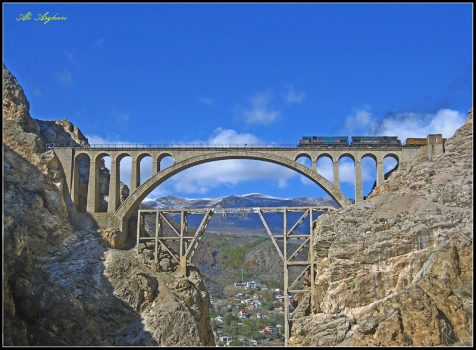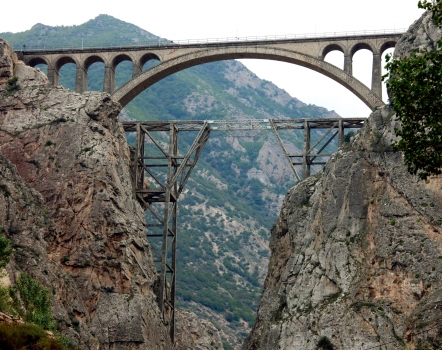General Information
| Name in local language: | Pol-e-Piroozi |
|---|---|
| Status: | in use |
Project Type
| Structure: |
Vaulted arch bridge |
|---|---|
| Function / usage: |
Railroad (railway) bridge |
| Material: |
Masonry bridge |
Location
| Location: |
Mazandaran, Iran |
|---|---|
| Coordinates: | 35° 54' 11.95" N 52° 59' 25.08" E |
Technical Information
Dimensions
| main span | 66 m |
Materials
| arch |
stone
|
|---|
Excerpt from Wikipedia
The Veresk bridge (Persian: پل ورسک) is a masonry arch bridge in northern Iran. It was constructed mostly by Austrians before World War II by leadership of an engineer named Walter Aigner, constructed during the reign of Reza Shah. It is located in the Veresk district of Savadkuh County, in Mazandaran province.
During World War II, it was known as the Pol-e Piroozi ("The bridge of victory"). The bridge stands 110 metres (360 ft) tall and ist arch measures 66 metres (217 ft) long. The bridge serves the Trans-Iranian Railway network in Northern Iran.
The Veresk bridge connects the railway between Tehran and the Caspian Sea region. It is located in Mazandaran’s Veresk district of Savad Kooh county, 85 kilometers south of Ghaemshahr and connects two of the mountains in the Abbas Abad region. The bridge is one of the masterpieces of the Danish engineering firm Kampsax, (consisting of Danish, German and Austrian engineers) serving the Trans-Iranian Railway network in Northern Iran. The construction of this bridge included craftsmen of many nationalities, including many Italian. The Master Carpenter for the construction of the lumber concrete forms was Giacomo Di Marco, from the Friuli region of Italy, and detailed in the book he authored. It has been said after finishing the bridge, people had a fear that the train wouldn’t be able to pass the narrow bridge and that it would break. As a result, the engineer and his family stood under it when the first train passed the bridge (local accounts claim that Reza Shah had asked them to do so anyway).
Near the bridge is a memorial structure built in memory of all the construction workers who lost their lives in the course of building the bridge and ist nearby tunnels. The Chief Engineer, Austrian Walter Aigner, following his wishes, is buried in the local cemetery of Veresk. Under the bridge is an underground tunnel through which trains pass after crossing the bridge and gradually dropping altitude and before pulling into the train station. During World War II, it was known as the Pol-e-Piroozi, or the bridge of victory. During the course of the war, Reza Shah was asked by Hitler to blow up all tunnels and bridges, including the Veresk Bridge, on Iran’s railway lines in order to delay the transfer of goods and reinforcement troops to the north for the Russians. He furthermore promised to replace and reconstruct all of such demolished structures following the Germans’ victory in the war. Reza Shah rejected the request. Today trains connecting Tehran to Gorgan or Sari pass over this bridge an average of 4 times a day.
Text imported from Wikipedia article "Veresk Bridge" and modified on July 22, 2019 according to the CC-BY-SA 4.0 International license.
Participants
Currently there is no information available about persons or companies having participated in this project.
Relevant Web Sites
Relevant Publications
- (1994): Brücken / Bridges. Ästhetik und Gestaltung / Aesthetics and Design. 4th edition, Deutsche Verlags-Anstalt, Stuttgart (Germany), pp. 90.
- (2018): Dynamic Behavior of Masonry Arch Bridge under High-Speed Train Loading: Veresk Bridge Case Study. In: Journal of Performance of Constructed Facilities (ASCE), v. 32, n. 3 (June 2018), pp. 04018016.
- (2022): A simplified beam model for the numerical analysis of masonry arch bridges –A case study of the Veresk railway bridge. In: Structures, v. 45 (November 2022), pp. 1253-1266.
- About this
data sheet - Structure-ID
20000641 - Published on:
25/03/2000 - Last updated on:
21/10/2016






